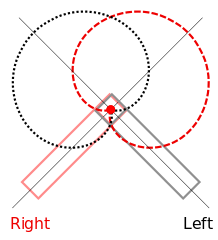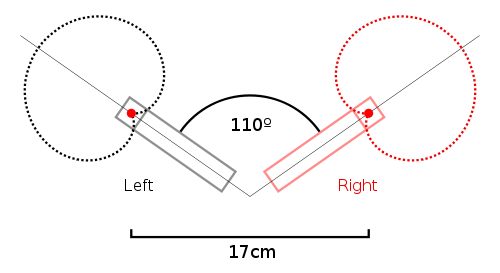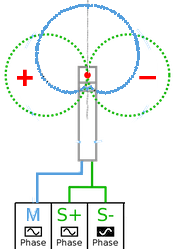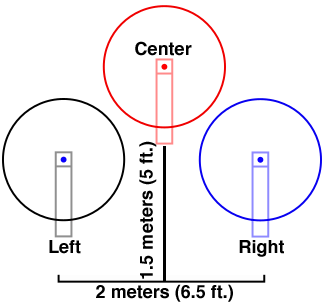Chapter Two: Studio Gear

3. Microphones | Page 5
Common Multiple Microphone Patterns for Stereo Recording
Stereophonic sound, or simply stereo recording was developed in the mid-1930's by Alan Blumlein in England, and then Harvey Fletcher in the US. The concept was to record and then recreate the sound panorama as we naturally hear it using the localization cues discussed in the previous chapter. True stereo, meaning a stereo image not created artificially through mono-sourced panning manipulation, requires two or more microphones, often a stereo pair (meaning the mics are at least the same pattern, if not model), or two or more mics set to different patterns, like the M-S stereo below. Because of their arrangement, these patterns may register a differentiated time of arrival, a differentiated sound pressure level or amplitude, and differentiated phase relationships for off-axis elements of the source. In this regard, these cues, which mimic the ITD and IID of hearing create a sense of our "being there." Of course, these can be manipulated and altered either in real time or in the studio after the fact to either make the image either "better," often the case with film soundtracks, or in some worst cases, annoyingly unnatural and just plain wrong. It is not uncommon to hear recordings, say of a piano concerto, where the soloist, additionally recorded by a spot mic, seems to be placed yards in front of the orchestra. In the classic mic patterns below, one concern of engineers was that if the stereo or multi-mic image were to be combined into a mono image, the phase cancellation would cause a metallic comb filter effect. This is still a concern for the electronic musician who may take his stereo recording samples and use them in a mono form. And phase cancellation of frequencies due to the spacing of stereo mics is still a concern, even for a stereo mix, where time-delay phase correction is not possible due to off-axis spill into another mic channel.
This page does not cover recording or reinforcing individual instruments with multiple microphones. There are many excellent guides for that in print and on the web, and a few of them are listed on Page 6: Microphone Resources.
Common Stereo Mic Patterns (plus the three-mic Decca Tree) are:
X-Y Coincident | Near-coincident and ORTF | Mid-Side (M-S) | Blumlein | A-B or Spaced Omnis | Decca Tree
X-Y Coincident
X-Y coincident pair: two cardioid mics aimed across each other at an angle between 90° and 135° and less than 12 inches apart to accurately recreate the way a listener hears with directional cues. A distance of more than 12 inches apart creates phase cancellation problems. X-Y pair capsules can literally be on top of each other, with no horizontal space in between. This creates a more mono-compatible image, since there are few directional cues left in the folded-down signal.
X-Y mic'ing creates an excellent stereo image when used fairly close to the source, but is not as convincing spatially at greater distances from the source. Since the mic capsules are so close, the stereo effect is created more so by the off-axis sound pressure differences of the response patterns rather than time-of-arrival and phase discrimination. The most common polar pattern to use for x-y mic'ing is the cardioid. Hyper- and supercardioids are also frequently used, particularly for room ambience, but at a distance the narrower field can produce an undesirable hole-in-the-middle effect. When used with two figure-8 patterns, it becomes a Blumlein pair mentioned below. With any rear lobes, it should be noted that the rear image appears in the opposite channels from the source.
Standard studio gear should be an x-y (or stereo) bar that allows for two mics on a single stand with variable spacing. And added element for stereo separation would involve adding an acoustic baffle between the mics, or using an artificial head to simulate the HRTF, like the binaural mic mentioned previously.
Near-Coincident and ORTF pair
A second stereo pattern, the near-coincident pair, is similar to X-Y coincident, except the microphones face outward at 90°-135°. Cardiod, hyper- and supercardioid mics may be used. One of the most well-used near-coincident patterns is the ORTF (Office de Radio Television Francaise), whereby two cardioid microphones are spaced ~7" apart and are angled outwards 55° from each other (110° total). The technique produces a wider stereo image with less center than x-y coincident, but does not require a baffle to simulate human hearing. It may experience some phase cancellation issues, particularly when summed to mono. However, like x-y mic'ing, the stereo image is better differentiated a closer distances. Both coincident methods capture less of the room ambience than spaced omnis, but often this is a good thing.
A variation of ORTF is NOS (Netherlandshe Omroep Stichting) in which the mics are angled at 90° outward but at a distance of about 12" (30 cm), which the Netherlands Broadcasting System believes captures more ambience than ORTF, but still has fewer phase problems than a widely spaced array. Other variants (usually small distance and/or angle differences) are RAI (21 cm, 100 degrees), DIN (20 cm, 90 degrees), Olson (20 cm, 135 degrees).
Mid-Side (M-S)
Another more recently popular coincident miking approach is called M-S or Mid-Side. Here a bi-directional (figure 8) called the side and cardioid mic called the mid are placed at right angles, with the figure-8 parallel to the source (recording more ambience) and the cardioid pointing directly on-axis (recording more direct). An M-S sum-and-difference decoder (now included in most DAWs as a plug-in), or as a hardware box, or a mixer setup (if the mixer can invert phase) takes the original figure-8 signal (labeled S+) and inverts it on another channel (labeled with S-). S+ and S- are panned hard left and hard right respectively, while the Mid(M) is panned center. This will yield M + S = left channel, and M - S = right channel. When combining the outputs of the two mics, the apparent width of the stereo field can be changed and the amount of direct sound vs. ambience can be adjusted after the fact in the studio by increasing or decreasing the amount of "side" vs. "mid." Producers also like M-S because it yields an excellent mono version by combining both sides so the figure-8 phase cancels out. A common variation of the above would be to use an omni as the Mid mic. M-S stereo was first proposed by Alan Blumlein in the 1930's.
Blumlein pair
Named for Alan Blumlein (chief engineer at EMI Studios in London during the 1930's, and a pioneer in stereo audio), a Blumlein pair uses two coincident (i.e. directly next to or one on top of the other) bi-directional (or figure-8) pattern microphones set up at 90 degrees to each other and ±45°off-axis.* This stereo mic'ing technique provides a strong center image, and good room ambience. Because of their coincident phase coherence, they have an excellent bass response. In addition, the overlap in patterns means the null points are covered, often in the other channel.
In the area in front of the microphones, you have basically the same behavior as we saw with the coincident cardioid pair. Changes in the angle of incidence of the sound source result in changes in the inter-channel amplitude differences, resulting in simple pair-wise power panning. Note however, that this pair is more sensitive to changes in angle, and therefore registers bigger swings in the location of sound sources with a Blumlein pair than with 90°cardioids. Sources on the rear left of the pair image on the right and sources on the right image on the left, and in reverse phase. Like the coincident patterns above, Blumlein becomes less convincing when placed too far from the source, and so additional outriggers are frequently used to cover wide ensembles rather than move the pair back. With the advent of surround patterns, some engineers have added a second rear-facing Blumlein pair on top of the forward-facing pair.
AB stereo or spaced pair
Some literature uses AB stereo and spaced pair interchangeably, but here we will make a distinction.
AB stereo recording, pioneered by Harvey Fletcher, places two mics more widely apart than coincident mic'ing, usually 12"-48" and parallel to the source. More often than not, omni patterns are used, though they can also be any of the other directional types. The stereo image is created primarily by the difference in time-of-arrival (to a lesser degree, amplitude differences) between the mics of a side-to-side differentiated source, for example, specific orchestral instruments. It is a good technique to use for a very wide ensemble where the environmental ambience is also important. AB stereo does not play well with mono mixdowns and is very susceptible to phase cancellations, particularly low frequencies, although these differences contribute to the sensation of the stereo image.
A spaced pair, usually omnis, is also useful for either wide ensembles or where cross-talk between two or more sound sources is undesirable. The setup, which again is parallel to the source, can be quite wide, but to avoid both phase issues and a hole-in-the-middle effect, the rule of 3:1 is a tried and true starting point. The rule states that the distance between the two mics should be at least three time the distance of the first mic from the source. So if you hang your mics 15 feet back from an orchestra, ideally they should be at least 45 feet apart.
Decca Tree
The Decca Tree was developed in the mid-1950's at British recording company London/Decca Records as a better means of recording large ensembles, such as an orchestra. It gives a very wide, spacious and mix-adjustable image due to intensity, time and phase cues. The T-shaped arrangement (which can be accomplished with either separate stands or a dedicated Decca Tree fixture) originally used three forward-facing omnis, pointed slightly inwards and downwards from high stands (because even omnis become somewhat directional at higher frequencies, including in particular the Neumann M50's originally used by Decca). It is now also used with cardioids and other directionals, as well as with the rear pair slightly panned outwards like the ORTF above. In fact, the addition of the center microphone was designed to eliminate the potential hole-in-the-middle effect possible with the ORTF. Standard placement of the tree is still often quite high and about ten feet behind the conductor. The spacing shown in the figure to the left was important to avoid phasing issues, but the two meter width of the rear pair is the suggested minimum, with wider arrangements suitable for larger ensembles. It is common now to add an additional pair of wide outrigger omnis to the mix. Additional variations (shown to me by Konrad Strauss, the I.U. Recording Technology director) involve cutting down the omni field of the rear mics with an acoustic baffle. You can see a variety of approaches, including the related five- or seven-mic Fukada Tree to record surround with similar arrangements here.
Stereo Pioneers
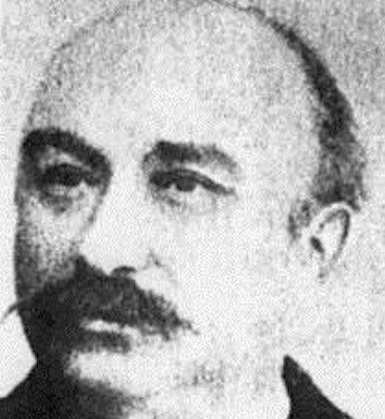
CLÉMENT ADER
French electrical and mechanical engineer Clément Ader developed the Paris telephone network in 1880. Shortly thereafter, he created the théâtrophone which broadcast plays and operas from the Paris Opera, using up to 80 telephone transmitters. First demonstrated in 1881, it is widely credited as the first example of stereo. The signals were mixed down to two channels and distributed through a network whereby listeners put a telephone receiver in each ear to hear the live event. Eventually, there were numerous subscribers who had dedicated boxes to hear the broadcasts up to several miles away from the Opera.
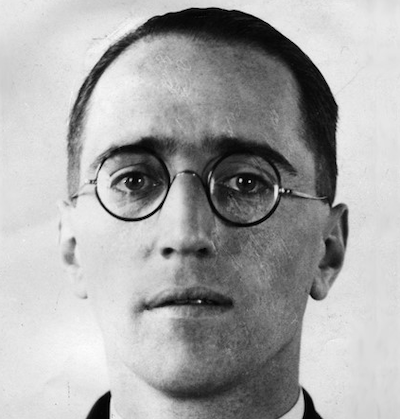
ALAN BLUMLEIN
Alan Blumlein was a remarkable British electrical engineer who, in the 19030's, pioneered much of the recording technology in use today. Credited as the "father" of stereo (originally called binaural sound)," he explored spaced pairs with a "shuffling circuit" that merged cross-talk above 700 Hz, developed a crossed pair*, developed stereo record-cutting techniques, microphone improvements and much more. His inspiration was to improve the poor quality of sound in the cinema and have the sound follow the actors, which he accomplished. Sadly, he died in a wartime airplane crash in 1942 at the age of 38.

HARVEY FLETCHER
Harvey Fletcher, mentioned earlier for his pioneering work in psychoacoustics, was also working in the US on stereo-imaged sound in the 1930's. He worked with the Philadelphia Orchestra to both broadcast and record stereo-imaged sound, sometimes using up to 80 microphones. He developed the Time-of-Arrival AB setup with baffles to simulate the human HRTF and provide greater channel separation. At the 1932 World's Fair, he and Bell Labs set up a binaural dummy names Oscar (a mic in each ear) in a glass booth. As someone walked around Oscar speaking, fair-goers outside the booth would experience the sound moving as well.
